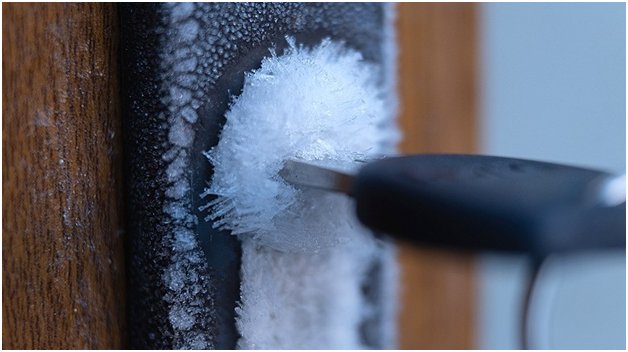Although winter has its share of picturesque mornings and cosy evenings by the fire, it does have a way of testing our patience with frozen door locks, for one thing.
The ability to open a frozen lock is a skill you simply need to have in cold winters.
Let’s see how.
Why Door Locks Freeze in Winter
Frozen door locks are one of the recurring problems in areas with cold weather and below-zero temperatures.
That’s because moisture gets inside the lock and freezes within the mechanism itself. Condensation, rain, or snow that seep into the small cracks of the lock are all causes for this. Hence, turning the key becomes difficult or impossible once temperatures drop as this moisture crystallises into ice.
In addition, frequent changes between warm and cold surroundings are a contributing factor.
For instance, heat from the engine or cabin will warm the lock as you drive in winter. The temperature disparity when you leave into the cold again can cause moisture to freeze and condense within the lock.
Moreover, the freeze-thaw cycle can cause internal lock component damage over time which results in long-term wear.
Frequent freezing weakens or corrodes elements like springs and pins and reduces the efficacy of your locks even after winter has gone.
How to Open Frozen Door Locks
When a lock freezes, the key is to gently warm it up. The following methods will help you unfreeze a stubborn lock:
Use a Hairdryer or Heat Gun
One of the most effective methods for thawing a frozen lock is to use a hairdryer or heat gun. Power in your hairdryer and direct the heated air to the lock, then hold it there for a few minutes.
Then, gently heat the metal in order to melt any ice inside. When using a heat gun, make sure you don’t overheat the lock since this can damage the internal parts.
Heat Your Key With a Lighter
If you don’t have a hairdryer, heating your key with a lighter can work wonders.
Try warming up the key carefully using a lighter or a match. Once it’s warm, insert it into the lock. The heat should melt the ice.
This method works best with metal keys but must not be attempted with plastic key fobs or ones with electronic components, as the heat can damage them.
You have to be patient. Wiggle the key gently as the heat transfers into the lock. Avoid forcing it, as you can end up with the entire key inside.
Apply De-Icing Spray
Deicing sprays, like WD-40 and commercial lock de-icers, are designed to rapidly dissolve ice.
This method is quite simple–just apply the spray immediately into the keyhole and wait a little before attempting to rotate the key.
Pro Tip: Maintain a compact canister of deicing spray in your purse, vehicle, or garage.
Use Hand Warmers or Hot Water
Hand warmers, often used by hikers or skiers, can also help unfreeze locks.
Simply press a hand warmer against the lock for a few minutes. The gentle heat will slowly melt the ice. Alternatively, you can pour warm, but not boiling, water over the lock.
Be cautious, though, as the water can refreeze if temperatures drop again. As a result, always dry the lock and lubricate it afterwards to prevent further freezing.
Use Hand Sanitiser
Having a hand sanitiser on you will help defrost a frozen lock even if you lack the proper tools.
Just dab some sanitiser onto your key and gently slide it into the lock. The alcohol will melt the ice so you can turn the key.
Preventing Locks from Freezing
Regular maintenance will help keep your locks ice-free throughout winter. This helps you avoid learning how to remove a broken key resulting from frozen or damaged locks.
To keep moisture out, use graphite powder or silicon-based lubricants. In addition, avoid oil-based products since they collect dirt and can clog the lock. We also advise you to spray lubricant every few weeks as it lowers the danger of freezing.
Plus, you can buy lock covers for outside padlocks, like those on sheds or garages. These covers keep moisture, snow, and rain from accessing the insides of your locks.
Deicing sprays are another must-have during winter, so always keep one on hand in your car and by your front door.
How to Remove a Broken Key from a Frozen Lock
If a key breaks inside a frozen lock, the situation can appear overwhelming, but it’s manageable with the appropriate strategy.
You will first have to determine how much of the key still shows. If you can still see some part of the key sticking out, you can remove it with simple pliers or tweezers.
Hold the visible part gently and attempt to straightly draw it out without twisting. Remember, any strong turning can possibly drive the key farther into the lock.
However, the job will be slightly more complicated if the key is totally buried inside the lock. Use a key extractor set especially meant to remove broken keys from locks. Usually found in most hardware stores, these kits have slender hook-like tools that fit the lock with the damaged key.
Once inserted, gently draw the tool towards you to grab the key fragment and pull it out.
Warming the lock up will help to melt any last ice before trying to extract the key. To do this, run the lock under a hairdryer, hot water, or hand warmer.
After thawing, make sure the lock is totally dry, as any moisture left inside can refreeze and aggravate the condition. Using a liquid de-icer can also assist in loosening the ice around the key and simplifying the extraction.
One further approach is using a bobby pin or a piece of rigid wire. Try to attach the wire or pin onto the jagged edge of the shattered key fragment next to the key.
If the fragment is too far for pliers or tweezers, this will enable you to retrieve it. Remember that this approach calls for accuracy and patience since moving the fragment farther into the lock can create more damage.
If these approaches fail, or if the key has become deeply entrenched in the lock, the safest choice is to contact an emergency locksmith. That’s particularly true when the freezing has resulted in interior damage, as experts can determine whether the lock needs replacement or repair.
Finally, repeated use of worn keys, especially in harsh conditions, raises their chances of cracking. Replacing old locks or keys will help you avoid future problems and stop keys from breaking inside frozen locks once more.
Conclusion
Frozen door locks are inconvenient, but they are solvable with the correct equipment and knowledge.
Understanding the reasons, preventive strategies, and how to remove a broken key can help you avoid these winter headaches.
Prevention is always preferable to cure, so maintain your locks on a regular basis. If everything else fails, do not hesitate to contact a locksmith. They can get you back inside and repair your lock’s functioning.


 Roofing Repair in Harrisburg: Protecting Homes Through Quality and Care
Roofing Repair in Harrisburg: Protecting Homes Through Quality and Care  Restoring Strength and Safety with Expert Concrete Repair in Marion
Restoring Strength and Safety with Expert Concrete Repair in Marion  Locked Out? How Total Security Locksmith Handles Emergency Lockout and House Lock Services with Ease
Locked Out? How Total Security Locksmith Handles Emergency Lockout and House Lock Services with Ease  How Takara Standard Kitchens in Singapore Evolve With Every Milestone
How Takara Standard Kitchens in Singapore Evolve With Every Milestone  The Hidden Benefits of Serviced Apartments for Rent in Singapore
The Hidden Benefits of Serviced Apartments for Rent in Singapore  Top 5 Benefits of Installing Roller Blinds in Singapore Homes
Top 5 Benefits of Installing Roller Blinds in Singapore Homes  DIY Log Cabin Christmas Decorations on a Budget
DIY Log Cabin Christmas Decorations on a Budget  Why Homeowners Choose LUKA Design and Build for Timeless Architecture and Modern Function
Why Homeowners Choose LUKA Design and Build for Timeless Architecture and Modern Function  Elevate Your Kitchen or Home Bar with the Right Print
Elevate Your Kitchen or Home Bar with the Right Print 







